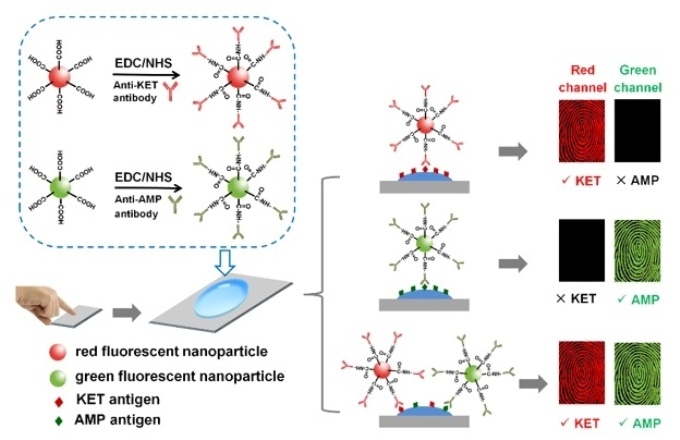Mar 15 2019
In a to-be-published paper in the upcoming issue in NANO, scientists from Zhejiang have revealed a new method of using nanocarrier-based biological fluorescent probes for identifying ketamine and amphetamine in hidden fingermark, in an attempt to fight drug abuse. This technique has the ability to include other drugs and molecules.
 (Image credit: World scientific)
(Image credit: World scientific)
Drug abuse has turned out to be an increasingly critical issue worldwide. How to find out whether a person is using drugs? Fingermark imaging and also drug detection in fingermark residues can merge the chemical information with personal identification for forensic purposes. Nanocarrier-based biolabeling has been used to produce latent fingermarks and concurrently gather extra chemical information from fingermarks with benefits of good selectivity and sensitivity.
However, current immunoassay techniques demonstrate the drawback that only one drug can be verified in a single fingermark by one test.
In practical instances, the types of drugs in fingerprints are usually not known. Furthermore, the number of fingerprints collected at the crime scene is normally less. Thus, it is essential to identify more than one drug in a single fingerprint concurrently using easy methods.
In this study, color fluorescent polystyrene nanoparticles are presented as nanocarrier in biological fluorescent probes (BFPs) for detecting amphetamine (AMP) and ketamine (KET) at the same time in latent fingermarks. In recent years, most commonly abused synthetic drugs in China are ketamine and amphetamine, which cause negative impacts on the human central nervous system and also lead to other health issues.
Antibodies are arranged on carboxyl modified nanoparticles by amide linkage with the help of N-hydroxysuccinimide (NHS) and carbodiimide (EDC). Each fluorescent color indicates a particular drug antibody, that is, green indicates amphetamine and red indicates ketamine. BFPs have the ability to selectively mix with the target analyte in ridge residue when incubated over the fingermark.
After eliminating the unattached BFPs, fluorescence signal originating from nanoparticles of the bound probes contributes to fingermark imaging. At the same time, the absence or presence of drug(s) can be directly identified by the fluorescent colors by examining the fingermark in green and red channels. Thus, fingermark imaging and parallel identification of dual-drug in a single fingermark are achieved by a single-step test without the need for using secondary antibodies.
This research is supported by Zhejiang Provincial Natural Science Foundation of China (LQ16B050002), Project of Educational Commission of Zhejiang Province of China (Y201533271), and National Key Research and Development Program of China (2017YFC0803606).